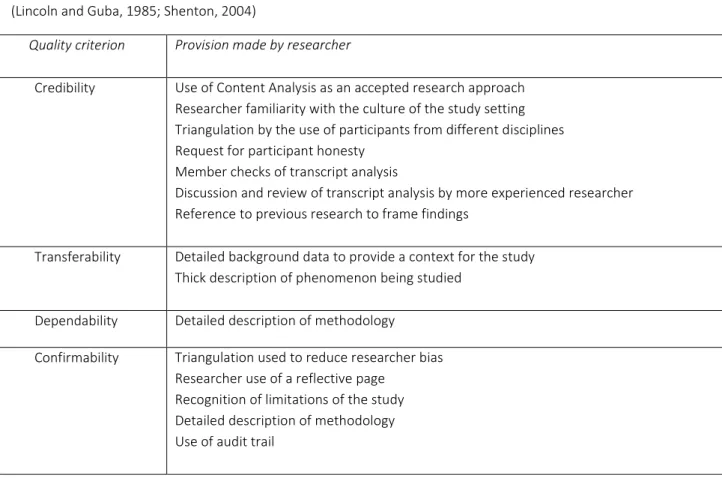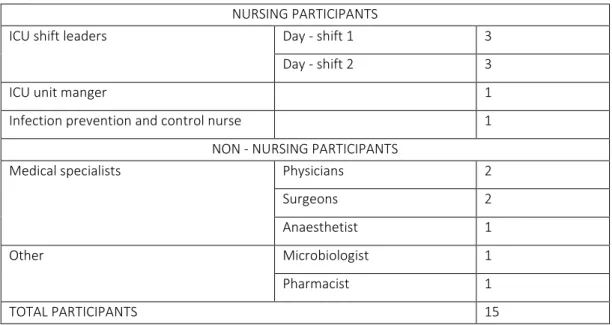The Critical Care Society of South Africa which inspires, educates and supports nurses and doctors in their care of the critically ill patient here in South Africa. Identifying the role of the ICU nurse in an AS team in a private ICU in South Africa.
BACKGROUND
In contrast, Africa has 24% of the global burden of disease, but only 3% of the health workers to serve that need (World Health Organization, 2006; Sheer and Wong, 2008). KwaZulu-Natal has some of the poorest rural populations in South Africa with an estimated 1.5 million HIV positive people (Cooke, Tanser, Bärnighausen, & Newell, 2010).
PROBLEM STATEMENT
PURPOSE OF THE STUDY
Participants said the ICU nurse was an important member of the antimicrobial stewardship team. Nurse participants were concerned that the pharmacist was not part of the antimicrobial stewardship program.
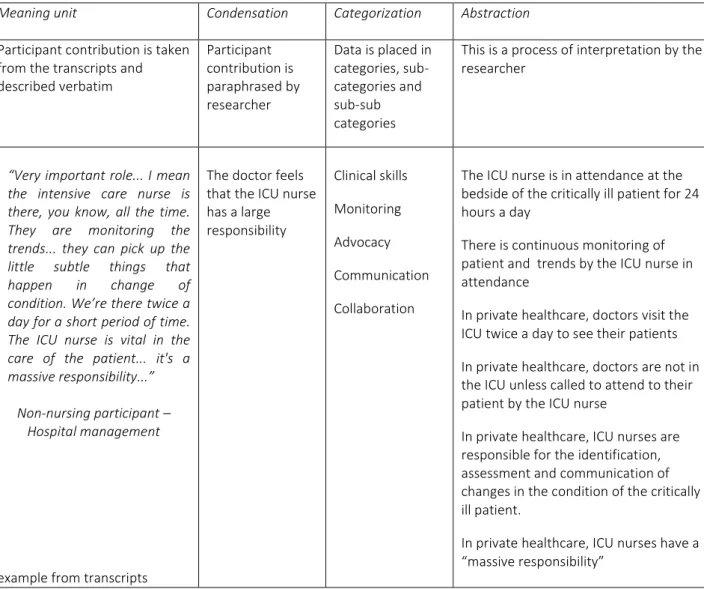
OBJECTIVES OF THE STUDY
RESEARCH QUESTION
SIGNIFICANCE OF THE STUDY
PRACTICE
RESEARCH
EDUCATION
POLICY DEVELOPMENT
OPERATIONAL DEFINITIONS
The term intensive care is sometimes used interchangeably with critical care in different parts of the world. In this study the intensive care nurse refers to the registered nurse who works and has experience in this clinical area of acute care and who may or may not have specialization training in intensive care.
SUMMARY OF CHAPTER
This term describes medical professionals who prescribe treatment, including antimicrobial therapy, for patients under their care in ICU. An initial review of current literature identified issues leading to the development of antimicrobial stewardship programs in intensive care units.
LITERATURE SEARCH STRATEGY
A further literature review was conducted during the course of the study as issues arose during the interview process, in accordance with the principles of qualitative research (Burns and Grove, 2009:91).
ANTIMICROBIAL RESISTANCE
ANTIBIOTIC/ANTIFUNGAL MISUSE
Increasing use of broad-spectrum antibiotics as empiric treatment leads to multidrug resistance with fewer antibiotics available to fight these infections (Alanis, 2005; Jacob and Gaynes, 2010) with countries worldwide facing untreatable bacterial infections due to of the emergence of pan-resistant gram-negative infections (FIDSSA, 2012). Patients whose condition required initial broad-spectrum therapy were noted to have an increased risk of infection with resistant strains and increased mortality (Brink, Botha, van den Ende, & Budavari, 2003).
DECREASED PRODUCTION OF ANTIMICROBIAL THERAPY
It is therefore necessary to restrict the current use of broad-spectrum agents if infections are to be effectively treated in the future (Paruk, Richards, Scribante, Bhagwanjee, Mer, & Perrie, 2012). The Infectious Diseases Society of America (IDSA) recently supported a limited population antibacterial drug approval pathway (LPAD) to address this (Spellberg, Powers, Brass et al. 2004).
PUBLIC HEALTH THREAT
ANTIMICROBIAL STEWARDSHIP
MONITORING OF INFECTIONS IN THE ICU
It is important that samples are collected correctly and recommendations are that at least 2 sets of blood cultures should be obtained before starting antimicrobial therapy. Both aerobic and anaerobic bottles should be used with at least one set drawn percutaneously and one set drawn through any invasive device (Dellinger, Levy, Rhodes, Annane, Gerlach, Opal, Sevransky, Sprung, Douglas, Jaeschke, Osborn , Nunnally, Townsend, Reinhart, Kleinpell, Angus, Deutschman, Machado, Rubenfeld, Webb, Beale, Vincent, & Moreno, 2012).
HOSPITAL-ACQUIRED INFECTIONS IN THE ICU
Within this study, there were 304 admissions with a mean APACHE II score of 17.4 and an ICU mortality rate of 37%. The critically ill patient is vulnerable to infection during hospitalization even without prior chronic disease.
INFECTION PREVENTION AND CONTROL IN THE ICU
Another South African study found that critically ill patients with severe sepsis in the ICU had a 59% mortality rate, compared with non-sepsis patients who had a 25% ICU mortality rate. Hand hygiene is a key element in infection control to prevent cross-transmission of pathogens by healthcare workers (Majumdar and Padiglione, 2012) and has been identified as one of the most important aspects of infection control in intensive care units (Drew, 2009; Deege). and Paterson, 2011; du Toit, 2012), but adherence to hand hygiene among healthcare workers is still poor (Perovic, 2011).
THE ICU NURSE AS PART OF THE ANTIMICROBIAL STEWARDSHIP TEAM
Charani, Castro-Sánchez and Holmes (2014), state that the nurse is underutilized to provide a foundation for antimicrobial stewardship. Nurses are an important part of antimicrobial stewardship (Charani, Cooke and Alison, 2010) with the South African Antibiotic Stewardship Program (SAASP) promoting the monitoring of antibiotic use by hospital pharmacists, microbiologists, doctors and nurses (Mendelson, Whitelaw, Nicol et al (2012).
SYMBOLIC INTERACTIONISM
The performance of these tasks and the acceptance of these tasks are known to members of other disciplines who are part of the antimicrobial stewardship team. The symbolic interactionist believes that people learn to ''see'' the world from their interactions with other people and will therefore develop shared meaning with situations, people and themselves through a process of interpretation.
SUMMARY OF CHAPTER
This chapter describes the methodology used in this study to examine the role of the intensive care nurse in the antimicrobial stewardship team from the different perspectives of various healthcare disciplines in this team. The research paradigm, research approach, study location, study population, sample strategy and size, data collection and analysis, data management, mechanisms to ensure quality of the study and ethical considerations for study participants are described.
RESEARCH PARADIGM
Each participant is seen to have a sense of a situation and multiple perceived realities of the participants are valued (Erlingsson and Brysiewicz, 2012). This study is expected to provide rich, in-depth data as the chosen participants are members of the antimicrobial stewardship team in this intensive care unit.
RESEARCH APPROACH
The microbiologist needed to be part of the antimicrobial stewardship program in this intensive care unit. The researcher is not involved in the organization of the antimicrobial stewardship program in this intensive care unit.
RESEARCH SETTING
SAMPLING
PARTICIPANT PROFILE
The nursing team of participants consisted of two hospital management nurses who oversee the daily implementation of the antimicrobial stewardship program and six clinical intensive care nurses who act as shift managers and conduct daily infection rounds as part of their antimicrobial stewardship responsibilities. The microbiologist was a representative of one of the private laboratories that serves the study hospital and is part of the weekly ICU antimicrobial stewardship teleconference.
DATA COLLECTION PROCESS
- DATA COLLECTION INSTRUMENT
- INTERVIEW PROCESS
- TRANSCRIPTION OF RECORDED MATERIAL
- DATA ANALYSIS
A process of abstraction followed to emphasize the interpretation of the data (Graneheim and Lundman, 2004). The ICU nurse is at the bedside of the critically ill patient 24 hours a day.
ACADEMIC RIGOUR
- CREDIBILITY
- TRANSFERABILITY
- DEPENDABILITY
- CONFIRMABILITY
Transferability can be described as the applicability of the findings of a study to other contexts (Shenton, 2004). Confirmability can be described as the degree to which the study reflects the contributions of the participants and the neutrality of the researcher (Shenton, 2004).

ETHICAL CONSIDERATIONS FOR PARTICIPANTS IN STUDY
The research methodology of this study was described and records kept of changes and events in the study. Written records of dates of interviews and further contact with the participants were kept over the period of the study to provide an accurate record or audit trail.
DATA MANAGEMENT
SUMMARY OF CHAPTER
Major categories were identified, some of which were predetermined and emerged from the study objectives and research questions, and subcategories were identified within the major categories. As significant differences were found in some of the contributions between the nurse and non-nurse participant groups, where relevant, these responses are discussed as representative of a particular group.
PRESENTATION OF FINDINGS
CATEGORIES AND SUB CATEGORIES
A non-nursing participant identified engagement with physicians as part of the ICU nurse's responsibility for antimicrobial stewardship. Participants believed that ineffective teamwork was a barrier to the development of the ICU nurse's role within the antimicrobial stewardship team.
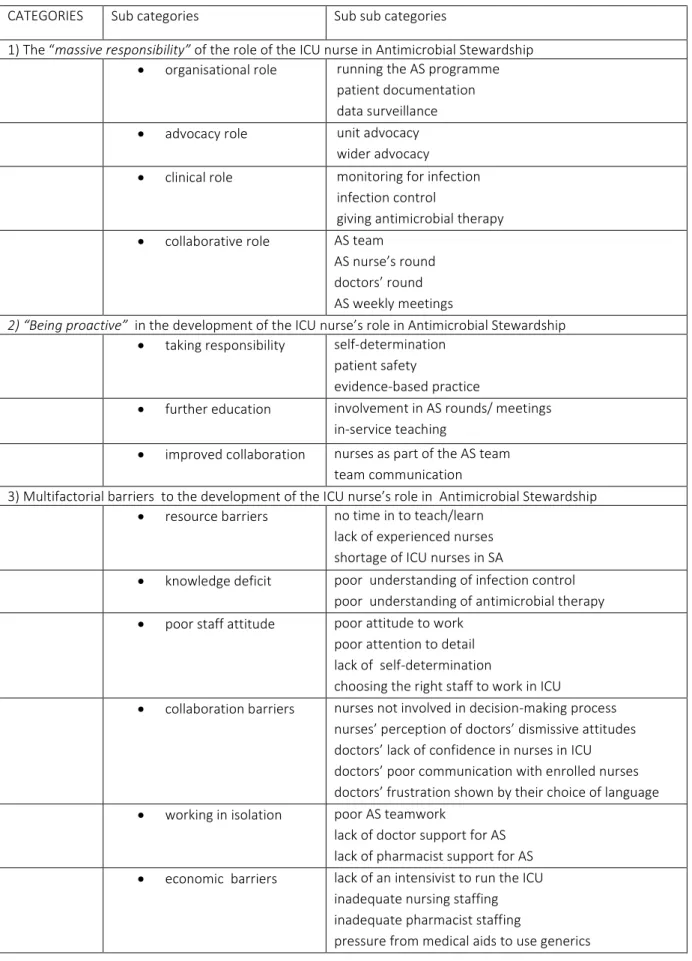
RESEARCH FINDINGS
THE “MASSIVE RESPONSIBILITY” OF THE ROLE OF THE ICU NURSE
- ORGANISATIONAL ROLE
- ADVOCACY ROLE
- CLINICAL ROLE
- COLLABORATIVE ROLE
- TAKING RESPONSIBILITY FOR SAFE PATIENT CARE
- FURTHER EDUCATION OF THE NURSE
- IMPROVED TEAM COLLABORATION
Participants felt that the weekly teleconference was an important aspect of the antimicrobial stewardship program. Participants felt that improving aspects of the antimicrobial stewardship team would contribute to ICU nurse development within this initiative.
MULTIFACTORIAL BARRIERS TO DEVELOPING THE NURSE’S ROLE
- RESOURCE BARRIERS
- KNOWLEDGE DEFICIT
- POOR STAFF ATTITUDE
- COLLABORATION BARRIERS
- WORKING IN ISOLATION
- ECONOMIC BARRIERS
I honestly don't think that the pharmacist adds any value... and then also [ ] the psychologist and the physiotherapist. A non-nursing participant believed that it was the hospital's responsibility to provide training for nurses working in the hospital.
SUMMARY OF CHAPTER
Nursing participants viewed daily shift leader rounds as another organizational aspect of the critical care nurse's role within the antimicrobial stewardship program. The role of the ICU nurse within the antimicrobial stewardship team was perceived as very important by both nurse and non-nurse participants.
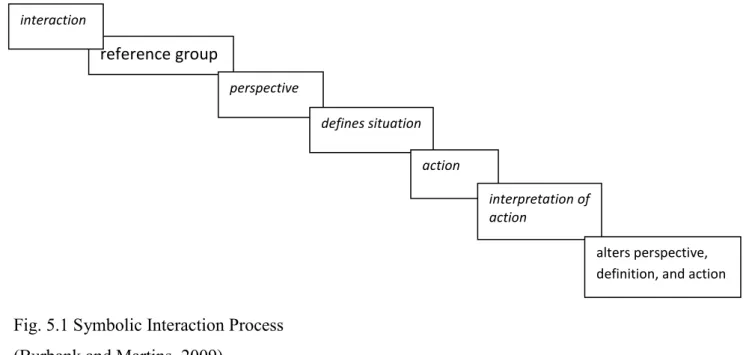
INTRODUCTION
DISCUSSION OF FINDINGS
THE “MASSIVE RESPONSIBILITY” OF THE ROLE OF THE ICU NURSE
- ORGANISATIONAL ROLE
- ADVOCACY ROLE
- CLINICAL ROLE
- COLLABORATIVE ROLE
- TAKING RESPONSIBILITY FOR SAFE PATIENT CARE
- FURTHER EDUCATION OF THE NURSE
- IMPROVED TEAM COLLABORATION
Participants did not mention management of endotracheal cuff pressure when discussing infection control aspects of the nurse's role in antimicrobial stewardship. Participants said that the antimicrobial stewardship team in this ICU consisted of nurses working on the ward, microbiologists and specialists.
MULTIFACTORIAL BARRIERS TO DEVELOPING THE NURSE’S ROLE
- RESOURCE BARRIERS
- KNOWLEDGE DEFICIT
- POOR STAFF ATTITUDE
- COLLABORATION BARRIERS
- WORKING IN ISOLATION
- ECONOMIC BARRIERS
Barriers to the development of the nurse's role in antimicrobial stewardship were considered by both nurse and non-nurse participants to be a poor attitude. Nurse and non-nurse participants said they were concerned about the lack of experienced nurses working in the ICU with particular reference to the lack of ICU-trained nurses.
SYMBOLIC INTERACTIONISM
SYMBOLIC INTERACTIONISM AND ROLE DEVELOPMENT
A group of doctors in KwaZulu-Natal calling themselves the "KwaZulu-Natal Specialist Network", representing approximately 300 doctors in practice from various hospitals in the private sector, have chosen to work together with the intention of improving the private health service with one of the objectives of this group to meet to discuss the best management of antibiotic use within the health sector (KZN Specialist Network, 2014).
SYMBOLIC INTERACTIONISM AND TEAMWORK
Each discipline has a strong foundation of behavior and expectations of the members of that discipline, therefore collaboration means examining this foundation in order to share responsibility (D'Amour, Ferrada-Videla, Rodriguez et al. 2005). The effects of this behavior are then interpreted and result in a changed perspective and definition of the situation, which has an effect on future behavior (Charon, 2007).
CRITICISM OF SYMBOLIC INTERACTIONISM
A 'downstream' approach to a problem takes place at the micro level and focuses on the problem itself. Burbank and Martins (2009) suggest that a critical perspective, traditionally seen as deviating from symbolic interactionism, should be combined with symbolic interactionism to address structural issues, rather than looking only at the level of the individual nurse .
SUMMARY OF CHAPTER
By using a more pragmatic approach and combining these two theoretical perspectives, nurses can develop more insight into role development and collaborative problems at the individual level while simultaneously identifying those macro-level factors that contribute to these issues. Finally, recommendations for the educational role of the Critical Care Association in South Africa for CPD policy development at the national level are discussed.
RESEARCHER REFLECTIONS
Personal reflections of the researcher are presented in this chapter along with a brief summary of the study and its limitations. Symbolic interactionism was chosen as the theoretical framework for this study and it was interesting to see how group behavior and interaction were perceived by the different healthcare disciplines.
SUMMARY OF STUDY
RATIONALE FOR THE STUDY
LITERATURE REVIEW
Kollef and Micek (2012) identify the multidisciplinary antimicrobial stewardship team as consisting of intensivists, infectious disease specialists, microbiologists and pharmacists. The literature has mainly identified the nurse as playing an important role in infection control (Ziady, 2012), but there was very little literature on the role of the ICU nurse in antimicrobial stewardship and Edwards, Drumright, Kiernan et al. 2011) suggest that this aspect of antimicrobial stewardship has not been adequately studied.
METHODOLOGY
We invite you to consider taking part in a study involving research into the role of the intensive care nurse in the antimicrobial stewardship team in the general intensive care unit of this hospital. I was made aware of a study entitled Exploring the role of the intensive care nurse in the antimicrobial stewardship team at a private hospital in eThekwini, South Africa, conducted by postgraduate student Joan Rout.
OVERVIEW OF FINDINGS
LIMITATIONS OF STUDY
RECOMMENDATIONS
RECOMMENDATIONS TO ADDRESSING RESOURCE BARRIERS
- RECOMMENDATIONS FOR OPTIMAL STAFFING
- POSITIVE PRACTICE ENVIRONMENTS
Hospital management and nurses must make every effort to create an environment that ensures patient safety. Hospital and nursing management must recognize that poor nursing care is a major factor contributing to nosocomial infections and microbial resistance.
RECOMMENDATIONS TO ADDRESSING KNOWLEDGE BARRIERS
- CLINICAL PRACTICE IN ICU
- IN-SERVICE TRAINING
- NURSING EDUCATION
- CONTINUING PROFESSIONAL DEVELOPMENT
This should include teaching about environmental resistance and the need to carefully consider the indication and choice of antimicrobial therapy in the critically ill patient. Consideration should be given to including a continuing learning page in the South African Journal of Critical Care Nursing (SAJCC) dedicated to nurses, which could lead to CPD points.
RECOMMENDATIONS TO ADDRESSING PROFESSIONAL BARRIERS …
- NURSE ATTITUDES AND POOR PERFORMANCE
- ANNUAL PERFORMANCE REVIEW
- POLICY DEVELOPMENT
- RESEARCH INTO THE ROLE OF THE ICU NURSE IN AS
RECOMMENDATIONS TO ADDRESSING COLLABORATION BARRIERS
Multidisciplinary involvement in issues of communication with other disciplines and understanding of the roles other disciplines play in antimicrobial stewardship should be encouraged. Research should be conducted to further investigate the relationships between ICU nurses and physicians in the critical care setting and how this impacts patient care in relation to nurse/physician interactions in ICUs in the private healthcare sector, physician non-adherence to infection control ie.
RECOMMENDATIONS TO ADDRESSING AS SUPPORT BARRIERS
RECOMMENDATIONS TO ADDRESSING ECONOMIC BARRIERS
What do you think are some of the barriers to developing the nurse's role in this antimicrobial stewardship team? I would like to request permission from the hospital management and the head of the ICU unit to conduct a research study on the role of the intensive care nurse within the antimicrobial stewardship team in the general ICU at this hospital.
CONCLUSION
